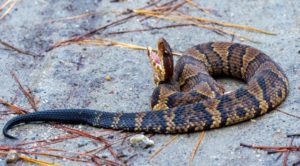
That’s what we are here for today. I dedicate this post to the removal techniques of cottonmouth snakes or water moccasins. It’s a two-stage process and is a bit time-consuming. So, you will have to be patient and consistent in your efforts. Rest assured, you will have a cottonmouth snake-free house and life.
Keep reading, and you will learn how to remove them from your place and prevent them from revisiting.
Table of Contents
How to Get Rid of a Cottonmouth Snake
As I said, the removal of cottonmouth snakes is a two-stage process.
1st Stage:
In the first stage, you have to deal with the snake: approaches for its removal from the property.
2nd Stage:
In the second step, you have to target the factors that bring these snakes to your doorstep.
1st Stage
You can rid a water moccasin off your territory through any of the given techniques.
-
Use Snake Repellents
Before you get handsy with a venomous cottonmouth, consider applying effective snake repellents.
a). Repellent Products
You can apply factory-made snake repellent to compel them to evacuate the premises. Many store-bought repellents can kill snakes. So, pick a product that deters them, not kills them.
You can also make a snake repellent at home by mixing essential oils, such as clove oil, cinnamon oil, cedarwood oil and peppermint oil.
Repellents have strong odours that snakes cannot bear and decide to move out.
b). Repellent Plants
A variety of plants are famous for deterring snakes. You can consider planting lemongrass, marigold, mother-in-law’s tongue, garlic and onion in rows to drive snakes like blunt tail moccasins away. This method will also prevent snake episodes from taking place again.
-
Set a Trap
Snake traps are your next best alternative if repellents fail. You just have to set a trap in the area the snake likes to hide or visit. The trap will do the rest.
- You can use a glue trap for baby cottonmouth.
- Set a minnow trap or a maze trap for an adult snake.
- Kill traps are also an option but I wouldn’t suggest those because many states have regulations against snake killing.
-
Snake Hooks & Tongs
It’s a dangerous approach because it requires you to get close and handsy with the snake. However, it’s also a very effective technique that will take the snake away from your place.
Attempt to remove a snake with a reliable snake hook or a pair of tongs only if you are trained and have protective clothing on.
-
Approach a Professional
Hiring a professional exterminator or wildlife removal service is the best of all the options. It’s both safe and effective. These experts have the proper equipment and can safely remove a snake from the vicinity.
Stage 2: How to Keep Cottonmouth Snakes Away from Your House
Now that you have removed the snake, move to the next stage: how to keep your house safe from future snake invasions.
Here, you have to target those factors that give cottonmouth snakes easy access to food and shelter.
-
Remove Water Source
Cottonmouth snakes are semi-aquatic creatures. So, they love to take a dip in the water now and then. Cover your poolside area and drains properly. Plus, keep the pond, drains and hose areas clean. Moreover, make sure the rainwater doesn’t pool anywhere on your property.
-
Remove Food Supply
Cottonmouths or any species of snakes come to your place if it gives them easy access to food. A Water Moccasin has a diverse palate, it preys on any creature from fish to frogs to rodents to salamanders to birds to squirrels.
Control the food supply to keep the snakes away from your house. Clean up food spills, bird seeds, leftover pet food and other pest attractants to discourage snakes.
Don’t leave your birdhouses and chicken coops unguarded.
-
Maintain Your Yard
Snakes prefer to hide in attics, sheds, burrows, tall grass, dense bushes, weed, woodpiles, rockpiles and under mounds of debris and junk. Cottonmouths are no exception. Snakes are less likely to stick around if:
-
- Your grass is short and plants are regularly trimmed.
- Your shed, attic and backyard and clean.
- Piles of junk, wood, rocks etc. are placed on shelves a couple of feet above the ground.
- Holes and animal burrows are filled with soil or small stones.
-
Seal Possible Entry Points
Cottonmouth snakes can get inside your building through broken windows, vents, drains, gaps in doors and vent ducts and cracks in the understructure. To ensure they don’t find a way inside your house, seal it. No, no I am not asking you to fortify your land like those emperors of Rome and Constantinople did.
Simply seal all the cracks, gaps and crawl spaces; repair damaged windows, vents and drains.
-
Build Snake Fence
You cannot erect massive walls around your property to protect it from snakes, but you can install snake-proof fencing. It’s an expensive method but will defend your property from enemies like snakes. Yes, cottonmouths also cannot crawl through snake fences.
Final Thoughts
A Cottonmouth snake, also known as a water moccasin, is a close relative of venomous rattlesnakes. That means it can inflict a venom-injecting bite if traumatised. Nobody wants his family or himself to go through such a trauma. You can take care of this problem in two steps: 1). Physically remove the snake through removal methods. 2). Target snake-attractant features that are drawing them to your house.
